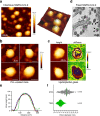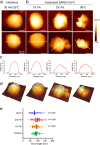Atomic force microscopy analysis of native infectious and inactivated SARS-CoV-2 virions
- PMID: 34088957
- PMCID: PMC8178396
- DOI: 10.1038/s41598-021-91371-4
Atomic force microscopy analysis of native infectious and inactivated SARS-CoV-2 virions
Abstract
SARS-CoV-2 is an enveloped virus responsible for the Coronavirus Disease 2019 (COVID-19) pandemic. Here, single viruses were analyzed by atomic force microscopy (AFM) operating directly in a level 3 biosafety (BSL3) facility, which appeared as a fast and powerful method to assess at the nanoscale level and in 3D infectious virus morphology in its native conformation, or upon inactivation treatments. AFM imaging reveals structurally intact infectious and inactivated SARS-CoV-2 upon low concentration of formaldehyde treatment. This protocol combining AFM and plaque assays allows the preparation of intact inactivated SARS-CoV-2 particles for safe use of samples out of level 3 laboratory to accelerate researches against the COVID-19 pandemic. Overall, we illustrate how adapted BSL3-AFM is a remarkable toolbox for rapid and direct virus analysis based on nanoscale morphology.
Conflict of interest statement
The authors declare no competing interests.
Figures


Similar articles
-
Insights on the Mechanical Properties of SARS-CoV-2 Particles and the Effects of the Photosensitizer Hypericin.Int J Mol Sci. 2024 Aug 10;25(16):8724. doi: 10.3390/ijms25168724. Int J Mol Sci. 2024. PMID: 39201411 Free PMC article.
-
Topography, Spike Dynamics, and Nanomechanics of Individual Native SARS-CoV-2 Virions.Nano Lett. 2021 Mar 24;21(6):2675-2680. doi: 10.1021/acs.nanolett.0c04465. Epub 2021 Jan 21. Nano Lett. 2021. PMID: 33474931 Free PMC article.
-
Structural characterization of β-propiolactone inactivated severe acute respiratory syndrome coronavirus 2 (SARS-CoV-2) particles.Microsc Res Tech. 2022 Feb;85(2):562-569. doi: 10.1002/jemt.23931. Epub 2021 Sep 9. Microsc Res Tech. 2022. PMID: 34498784 Free PMC article.
-
Safety and potency of BIV1-CovIran inactivated vaccine candidate for SARS-CoV-2: A preclinical study.Rev Med Virol. 2022 May;32(3):e2305. doi: 10.1002/rmv.2305. Epub 2021 Oct 26. Rev Med Virol. 2022. PMID: 34699647 Free PMC article. Review.
-
Hunting coronavirus by transmission electron microscopy - a guide to SARS-CoV-2-associated ultrastructural pathology in COVID-19 tissues.Histopathology. 2021 Feb;78(3):358-370. doi: 10.1111/his.14264. Epub 2020 Dec 1. Histopathology. 2021. PMID: 32981112 Free PMC article. Review.
Cited by
-
Physical virology: how physics is enabling a better understanding of recent viral invaders.Biophys Rev. 2023 Jun 17;15(4):611-623. doi: 10.1007/s12551-023-01075-4. eCollection 2023 Aug. Biophys Rev. 2023. PMID: 37681101 Free PMC article. Review.
-
Optimized production and fluorescent labeling of SARS-CoV-2 virus-like particles.Sci Rep. 2022 Aug 27;12(1):14651. doi: 10.1038/s41598-022-18681-z. Sci Rep. 2022. PMID: 36030323 Free PMC article.
-
Validation of flavivirus infectious clones carrying fluorescent markers for antiviral drug screening and replication studies.Front Microbiol. 2023 Sep 15;14:1201640. doi: 10.3389/fmicb.2023.1201640. eCollection 2023. Front Microbiol. 2023. PMID: 37779700 Free PMC article.
-
High-throughput super-resolution analysis of influenza virus pleomorphism reveals insights into viral spatial organization.PLoS Pathog. 2023 Jun 30;19(6):e1011484. doi: 10.1371/journal.ppat.1011484. eCollection 2023 Jun. PLoS Pathog. 2023. PMID: 37390113 Free PMC article.
-
Unraveling the Nanomechanical and Vibrational Properties of the Mayaro Virus.ACS Omega. 2024 Nov 26;9(49):48397-48404. doi: 10.1021/acsomega.4c06749. eCollection 2024 Dec 10. ACS Omega. 2024. PMID: 39676942 Free PMC article.
References
Publication types
MeSH terms
LinkOut - more resources
Full Text Sources
Medical
Miscellaneous

